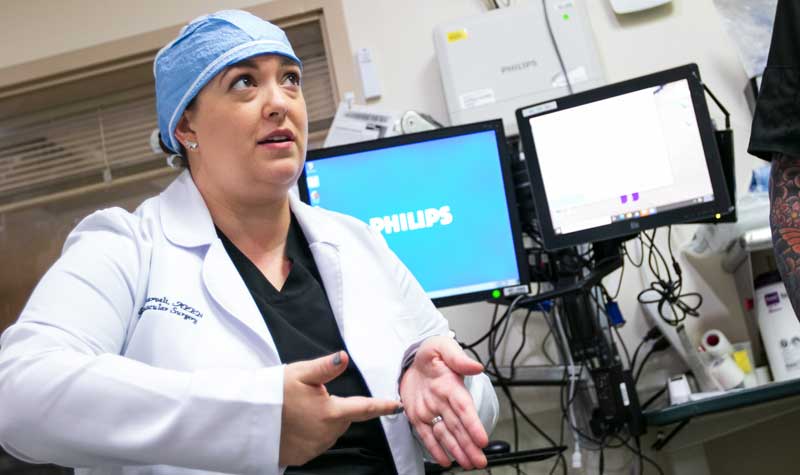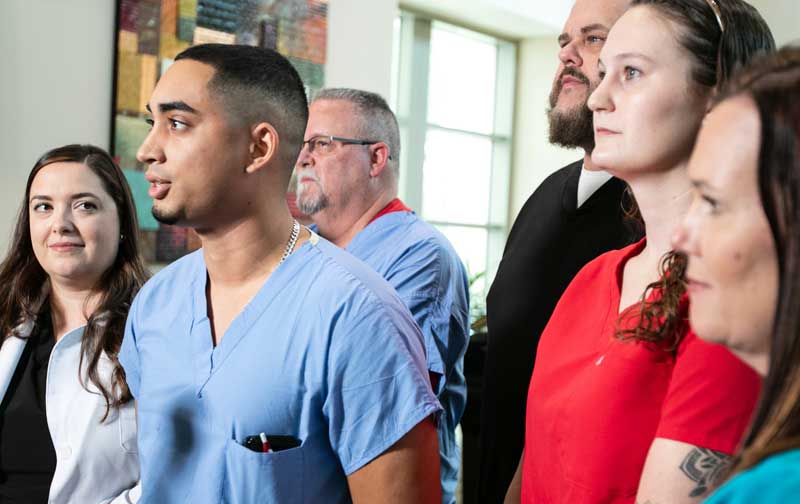Health First’s Holmes Regional Medical Center Returns Airman, 23, To Duty Following Injury
By Space Coast Daily // January 18, 2023
U.S. Air Force Staff Sgt. Wesley Smith: 'I knew that something pretty bad had happened'

Health First’s Holmes Regional Medical Center is both a Level II Trauma Center and a Joint Commission-certified Thrombectomy Center. For Staff Sgt. Wesley Smith, it was mission-critical.
BREVARD COUNTY • PATRICK SPACE FORCE BASE, FLORIDA – A little beachside R&R is about the farthest thing from hazard duty a U.S. service member could name, but for U.S. Air Force Staff Sgt. Wesley Smith, it turned out to be life threatening.
This summer, Wesley and some friends converged on a beach just outside the gates at Patrick Space Force Base. Swimming back to shore, a wave sucked him below, spiraling him along the ocean floor.
“After I got hit, I started to ragdoll in the spiral of the wave,” he says. “And I knew that something pretty bad had happened.”
In the crunch of the impact, the bones in Wesley’s neck dissected the basilar artery, peeling away layers of arterial tissue without breaching the vessel. The result was an unusual slow-motion stroke.
“I had sleep paralysis once. That was terrifying, and that started happening to me in the ambulance,” he recalled.
“I thought, ‘I’ll be able to communicate with eye movements,’ but they were talking to me about moving my hands and stuff and I couldn’t, and they worked their way up to my eyes. ‘Can you move your eyes?’ I would try and I couldn’t.”


REPAIRING THE ARTERY
Health First’s Holmes Regional Medical Center is the area’s only Thrombectomy-capable Stroke Center, according to The Joint Commission. A thrombectomy is a stroke-reversing catheterization process.
In a stroke, blood flow to the brain is impeded either because a blood vessel is hemorrhaging or, more commonly, is blocked.
In Wesley’s case, the basilar artery was ballooning, preventing the regular flow of oxygenated blood. The Neuroendovascular team inserted a stent into the wounded artery, restoring rigidity at the vessel wall and reversing the stroke.
“Wesley’s tear of his artery was a little unusual. Instead of up and down, the tear was side to side,” says Nurse Practitioner Samantha Westervelt. “You don’t think trauma can cause a stroke but it can.”

AI FOR FAST STROKE RESPONSE
Westervelt said Wesley was fortunate to be rushed to Holmes Regional, the area’s only Level II trauma center with world-class Neuroendovascular services.
Each minute his stroke went untreated “the more severe and the more permanent” his impairments would become, says Westervelt.
“So we’ve really tried to grow and streamline how the department works. We work closely with trauma, trained on recognizing strokes and the correct tests to run. So instead of having to wait for them to call the physician, they can run those tests themselves and the physician can read those results at home on their phones utilizing Viz.ai.”
Viz.ai is artificial intelligence-based software over smartphone that spots strokes and alerts stroke teams.
“The Neuroendovascular team is always available and ready to come in,” Westervelt says, “even in the middle of the night. This is a service that not many hospitals have.”
Despite his age, the trauma team was the first to identify Wesley’s neurological decline and recognize it as signs of a stroke, despite his age. They began running tests, saving precious time.

REWARDING RECOVERY
“The case truly highlights the services and capabilities of the Neuroscience department here at Health First,” Westervelt said.
“From the quick assessments of the trauma team to the fact that his physicians could see his scans from home – it was the middle of the night and they were able to call the team and very quickly get him ready for surgery. Then on to the ICU nurses and staff who took great care of him afterward. Airman Smith received exemplary treatment.”
Greg Darnell and Jeff Beal are both Radiologic Technicians in the Neuroendovascular Suite as well as fathers of sons about Smith’s age.
“When we were introducing contrast into the artery, and you see that it’s dissected, it hits home, what’s happened to him,” says Darnell. “I have a stepson his age. That we’re able to identify his stroke, treat it, and that he’ll be able to get back this normal life, it makes it all worth it.”
“This work makes you proud to do what you do,” says Beal. “At 2 a.m., you may not be real happy to come into work, but when you can have an outcome like this – I’ll do it every day.”
Wesley says his recovery is so complete that he has to make himself remember what was at risk.
“Apart from walking out of the water, I didn’t have to do anything. I went to sleep and then woke up on Saturday and I was fine.
“So, I have to remind myself that it happened. And I think about all the time, I would be happy just to live – but I get to walk.
I was just happy to walk – but I get to have my job back. Like, I was able to recover to the point where I’m able to keep my job in the Air Force, and I love my job.”
Visit HF.org/news to find out what’s happening at Health First.















